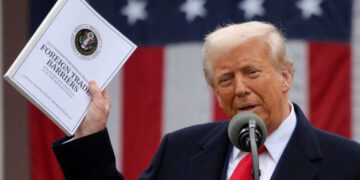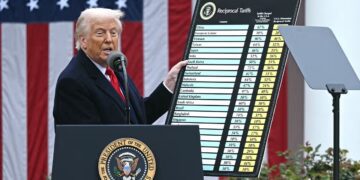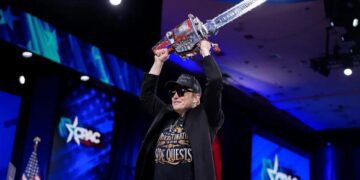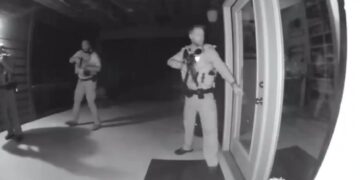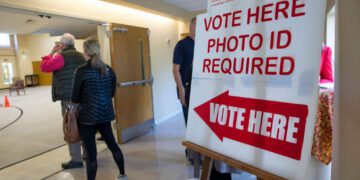By John F. Di Leo -
(George Washington as a young surveyor. 1881 illustration entitled "Old Times in the Colonies" by Charles Carleton Coffin)
Our second President, John Adams, attended Harvard, the oldest college in America, already over a hundred years old when he attended.
His successor in the White House, Thomas Jefferson, attended William and Mary… and his successor, James Madison, attended the College of New Jersey (now known as Princeton).
Most of our earlier presidents, those who led the Continental Congress and its successor body, the Confederation Congress, were similarly well-educated men. For example, John Jay went to King’s College (now Columbia); Thomas Mifflin attended the College of Philadelphia.
The various colleges of both the United States and Great Britain were well represented by our Founding Fathers… and yet, the greatest of them all, George Washington – surveyor, planter, trader, legislator, executive, and soldier – had no “higher education” at all. How ever did he manage it?
(Washington's Birthplace National Monument, National Park Service)
A Colonial Childhood
George Washington was born in Virginia, on one of his father’s several farms (presumably at Popes Creek), on February 11, 1731 (old style), which we celebrate as February 22, 1732, due to the United Kingdom’s 1750 decision to join the rest of Europe in using the Gregorian calendar.
Young George was the oldest son of Augustine Washington’s second wife, Mary Ball. During the senior Washington’s first marriage, the family prospered, and could afford such colonial planter luxuries as sending their sons to England for a proper education. Augustine Jr. (known as Austin) and Lawrence, young George’s older half-brothers, spent some years attending Appleby School in northern England, as had been the custom for generations of Washington men.
Unfortunately, when it was almost time for young George to go, his father died at the age of 48, leaving two young adult sons from his first marriage, and five children under 12 for his second wife to care for.
Mary Ball Washington might have been able to afford to continue the tradition, but she didn’t think she could, so she decided to keep her eldest son at home, vetoing the idea of going to England, also vetoing the older brothers’ plans for young George to apply for service in the Merchant Marine or Royal Navy. She believed he needed to get on with the responsibilities of adulthood.
When Gus Washington died, he had sufficient estates to provide for his large family, with thousands of acres all over northern Virginia and Maryland. His will carefully split up the farms so that his widow and children would not go without. But with five of those heirs under twelve, it wasn’t like they could work the farms themselves; Mary Washington would be relying on Lawrence and Austin, then, soon, on George too, to run these many properties. Lawrence and Austin, after all, were both adults themselves, and while happy to help, they had their own lives to build.
(the Lower Church School, built in 1711, photo by Michael Kotrady)
A Hybrid Education
By the time his father died, young George was eleven, and had certainly received the foundation of an elementary education. Records of his youth are scant, but historians believe that his father had hired a convict indentured servant, or possibly a series of them, to tutor the children of his second marriage. This private tutoring at home included what we would expect: grammar, math, reasoning, speaking, geography and history, an appropriate elementary foundation both for more advanced study in the Appleby years that were never to materialize, and in preparation for a career in farming, surveying, ironworks, international trade, or – who knows? – perhaps even the military.
After his father’s death, Appleby now being out of the question, he embarked on a new mix of educational sources. He appears to have studied at the nearby Lower Church School for some time, and he moved in with his brother Austin at Mattox Creek for a while, so he could attend the nearby Henry Williams School. His new teachers, perhaps dissatisfied with his progress from private tutoring and home study, had him repeat much of his earlier work (we know this because his childhood copybooks were preserved).
Just as Mary Washington had a plan – to keep George home to take care of her – so too did his brothers have a plan.
After completing his studies at Appleby School, Austin had stayed on as a teacher there himself for three years. Austin was therefore able to supplement the rural Colonial schools’ program with everything else George would have studied in England, from literature to mathematics.
Similarly, Lawrence, who had served with the Royal Navy during the War of Jenkins' Ear, instructed him in the basics of military training, and hired a fencing instructor for the lad… until his mother put the kibosh on the Navy plan.
On top of all this, George Washington was a voracious reader, spending as much time as he could in his brothers’ homes, taking advantage of their respectable personal libraries, mastering complex subjects such as the higher practical mathematics of engineering. Between hired tutors and his brothers, and especially the diligent study he pursued on his own, he was to become the greatest poster child for what we call home-schooling today.
Eventually, these various branches of training coalesced around the specialty of surveying.
(George Washington's Surveying Gear – photo by the Mount Vernon Ladies Assoc.)
Chains and Markers
Surveying had been one of the elder Washington’s talents, as he grew his holdings across Virginia and Maryland, and it came easily to his sons as well.
A Virginia surveying crew was typically a team of four – a leader, two chainsmen and a marker. A big job in the American frontier required the skills of an outdoorsman as well as technical knowledge of the craft… and young George assisted his father, and then studied on his own, until he was an expert.
Always a worthwhile profession, surveying was a particularly valuable one in Virginia at the time. Planters and speculators were moving west, and boundaries needed to be mapped as land became available, both on the eastern side of the Alleghenies, and hopefully soon, to the west as well. Clients often paid for surveying services with land, so, if one was good enough at surveying others’ property, one would soon have property of one’s own.
On top of all this, George’s neighbors and in-laws, the Fairfaxes (Lawrence had married into the family) were in the midst of a significant court case in England known as the Fairfax Grants. In anticipation of the Restoration, King Charles II had promised a huge amount of land in the New World to his key supporters, and the case had been winding its way through the courts for decades. As luck would have it, the case was to be determined in the Fairfaxes’ favor, affecting the disposition of some 5.2 million acres in the Northern Neck of Virginia, primarily between the Rappahannock and the Potomac, right when young George Washington was just becoming proficient at surveying.
George was a part of the Fairfax surveying team from the day it started on March 11, 1748, reporting to James Genn, the main surveyor, and he soon demonstrated a natural command for the profession. By the completion of that successful and high-profile internship, he was respected as a professional. He was soon doing independent surveying jobs for the Fairfaxes and others, earning a respectable salary, and concurrently adding land to his own holdings.
In July of 1749, just over a year after the project on the Fairfax grants, George Washington was commissioned the official Culpeper County Surveyor. He had begun his career, holding his first government position.
He was seventeen.
What is an Education?
Americans all value education highly, don't we? Conservative or liberal, young or old, one thing we can agree on is the importance of the young being prepared for life somehow; where we disagree is usually on which education method is most effective.
Which are better: the government schools or the religious schools? Large ones or small ones? College-preparatory or vocationally focused?
A generation or two ago, these questions also included whether co-ed or single-sex was preferable, whether local day schools or distant boarding environments were better.
In Washington's day, today's options didn't even exist: there was no archipelago of government-operated schools, overlaid with an archipelago of smaller diocesan Catholic schools to give the appearance of choice. There was homeschooling, which could be supplemented with private tutors, and there were little independent schoolhouses, usually run by a single teacher, sometimes attached to a local church. That system worked rather well; it produced the Founding Generation, the greatest generation in history.
Perhaps, today, we should even question whether education is in any way the responsibility of government – whether it’s appropriate at all for one citizen to be taxed to pay for the education of his neighbor’s children, especially if he can hardly afford to educate his own children. Even if the government school – which we Americans refer to by the euphemism “public school” is a relatively good one, that fact alone doesn’t answer the moral question as to whether government should be determining the subjects for this or that individual child to study, does it?
In the case of young George Washington, an education was seen – by his father and mother, and by his elder brothers – as a preparation for certain things that were sure to come for him: civic involvement, providing for his family, a career path. It was a mixture of classic literature and world history, and what we would call "the three Rs:" reading, writing, and arithmetic. It involved tools that are derided today, such as memorization through hand-copying; trite it may be, but the method certainly worked.
Washington’s education included two things we might today call apprenticeships: his hands-on experience in agriculture and surveying, both of which, together, were to make him a successful businessman while still a young man.
Surveying required both the mathematics and drafting skills he learned in school and the use of precision instruments that can only be mastered in the field. Agriculture requires both knowledge of botany and years of experimentation to find what methods work on one’s own particular land, as the slightest variance in things like soil, sun, slope, and drainage can seriously affect a farm’s yield.
It’s the scientific method; trial and error over the years, along with careful lifelong study, were to make George Washington one of the most successful farmers in America for a while, as he diversified his crops and learned how to market them to the greatest advantage.
George Washington’s education wasn’t just a group of tutors, and it wasn’t just his private reading either. It wasn’t limited to his time at a desk or his time in the forests, carrying chains and pads and drafting pencils. It was the combination of all of the above – learning at the side of an accomplished father and two accomplished brothers, being a part of a historic surveying project, observing the variety of farms in Virginia and thinking through how their many differences could apply to his own inherited land at Strother Farm, Deep Run, and Fredericksburg… and the additional land he was soon to begin acquiring.
Those who champion vocational education today are right – learning a trade is indeed a key part of a complete education. But those who focus only on a single trade, deriding the liberal arts, are missing the point. Mastering blacksmithing or surveying or farming is not enough. Every citizen still needs to be able to communicate in life, to manage his household accounts, to make an intelligent decision in the voting booth on election day. This is why reading and writing, and math and history, are needed by everyone, regardless of their careers. When George Washington studied the Magna Carta and the Petition of Right, when he read Addison’s “Cato” and Hawkins’ “Youths’ Behavior”, when he studied the news from Williamsburg and London, he was ensuring he would be prepared for whatever the winds of fate called upon him to do.
George Washington went on to have quite a career. He was appointed a district commander of Virginia’s colonial militia at twenty, and served as Commander-in-Chief of the Continental Army during the War of Independence. Between those two periods of military service, he served twenty years in the colonial legislature, as a member of Virginia’s House of Burgesses, then served as President of the Constitutional Convention and as the first chief executive of the United States. And throughout this long career, he carefully diversified his farms, moving away from tobacco alone to raising wheat, corn, carrots, apples and more, adding such services as ironworks, and clothing and cider manufacture, to become self-sufficient.
Some of Washington’s contemporaries questioned how he could accomplish so much, when, after all, “he had had no education.” But it was their premise that was faulty: they just didn’t know how to define the word “education.”
Some believe that an education is a piece of parchment, issued by a college or university. And that certainly can be.
But an education, at its heart, is a preparation for life – for parenthood and citizenship. It is the preparation that enables a citizen to provide for spouse and children, to support his church or synagogue, to create jobs for his fellow citizens and engage in commerce with his community, and perhaps even to serve admirably in public office.
By those standards, George Washington’s education – that mix of private tutors, family instruction, self-guided study and practical apprenticeships – was the best education ever delivered in this country, because his education prepared him to be George Washington, the visionary of American independence, the man who, more than any other, set the wheels in motion for the United States of America.
Copyright 2022 John F Di Leo
Bibliography: For further details on the key information of President Washington’s early schooling, please “All Cloudless Glory” by Harrison Clark, and “George Washington, A Life,” by Willard Sterne Randall… plus the great trove of articles available online on Mount Vernon’s website.
John F. Di Leo is a Chicagoland-based trade compliance trainer and transportation manager, writer and actor. A one-time county chairman of the Milwaukee County Republican Party, he has been writing regularly for Illinois Review since 2009.
A collection of John’s Illinois Review articles about vote fraud, The Tales of Little Pavel, and his 2021 political satires about current events, Evening Soup with Basement Joe, Volumes One and Two, are available, in either paperback or eBook, only on Amazon.
Don’t miss an article! Use the free tool in the margin to sign up for Illinois reviews free email notification service, so that you always know when we publish new content!






